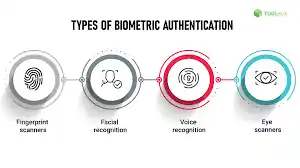Various Types of Biometric Authentication Methods

Ensuring the security of our personal and sensitive information is of paramount importance.
With traditional authentication methods proving to be vulnerable, the adoption of biometric authentication methods has gained significant traction.
These advanced techniques offer a higher level of security and convenience by relying on unique physical or behavioral attributes.
Let’s delve into the different types of biometric authentication methods that are shaping the future of digital security.
Fingerprint Recognition
One of the most recognizable biometric methods is fingerprint recognition.
Every individual possesses a unique fingerprint pattern, making it an effective means of identification.
This method involves capturing the ridges and valleys on a person’s fingertip and converting them into a digital code.
From unlocking smartphones to accessing secure facilities, fingerprint recognition has become a widely adopted biometric authentication method.
Facial Recognition
Facial recognition technology analyzes facial features to identify individuals.
It captures and measures various points on the face, such as distance between the eyes and the shape of the jawline.
The system then compares these measurements to a stored template for authentication. Facial recognition is commonly used for unlocking devices and granting access to secured areas.
Iris Scanning
Iris scanning involves capturing the intricate patterns in the colored part of the eye, known as the iris. Like fingerprints, iris patterns are unique to each person.
This method is highly accurate and is often used in high-security environments.
Its non-intrusive nature and resistance to false positives make it an appealing choice for biometric authentication.
Voice Recognition
Voice recognition relies on the distinct vocal characteristics of an individual.
The system records speech patterns, pitch, tone, and other voice-related attributes to create a unique voiceprint.
While it’s less commonly used compared to other methods, it finds applications in phone-based authentication and voice assistants.
Behavioral Biometrics
Unlike physical attributes, behavioral biometrics focus on patterns of behavior.
This includes keystroke dynamics, gait analysis, and even the way you hold a device.
Behavioral biometrics add an extra layer of security by examining how an individual interacts with technology over time.
Biometric authentication methods offer several advantages over traditional methods like passwords or PINs.
They are inherently more secure as they rely on unique characteristics that are difficult to replicate.
Additionally, they eliminate the need for users to remember complex passwords, making the authentication process more convenient.
Frequently Asked Questions
Are biometric authentication methods completely secure?
Biometric authentication methods offer a higher level of security compared to traditional methods, but they are not immune to risks.
Biometric data can be stolen or replicated in some cases. Implementing additional security layers, such as multi-factor authentication, can enhance overall security.
Can biometric data be hacked or stolen?
While it’s challenging to duplicate biometric traits, instances of biometric data breaches have been reported.
Storing biometric data securely and using encryption are essential steps to prevent unauthorized access. Biometric templates should be stored instead of raw data to add an extra layer of protection.
What happens if my biometric data is compromised?
If biometric data is compromised, it’s not as simple to change as a password. However, most systems use biometric templates that are useless for reverse engineering the original data.
Still, in case of a breach, it’s advisable to inform the relevant authorities and update your authentication methods.
Can I use biometric authentication for all my devices?
Many modern devices, including smartphones and laptops, support biometric authentication methods. However, compatibility can vary based on the device’s hardware and software capabilities. It’s important to ensure that your device supports the specific biometric method you intend to use.




